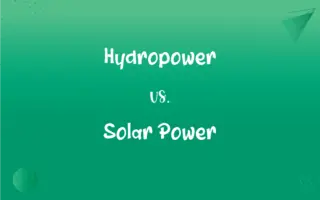Active Components vs. Passive Components: What's the Difference?
Edited by Janet White || By Harlon Moss || Updated on October 17, 2023
Active components can control the flow of electricity and amplify signals, while passive components cannot amplify and only respond to the current flowing through them.

Key Differences
Active components are integral parts of electronic circuits that have the ability to control the flow of electric current. On the other hand, passive components don't have this control capability but instead, they rely on the current or voltage present in the circuit to function.
Active components usually require an external power source to function optimally. In contrast, passive components do not require any external power source but operate by using the energy from the circuit itself.
The role of active components in a circuit is often to amplify signals or to act as a switch. Conversely, passive components mainly resist, store, or provide a specific amount of energy in the circuit without amplifying it.
Examples of active components include transistors, diodes, and operational amplifiers. In juxtaposition, resistors, capacitors, and inductors are examples of passive components.
In essence, active components drive the operation and function of an electronic circuit. Passive components, meanwhile, condition the signal or store energy but don't influence the core operation of the circuit.
ADVERTISEMENT
Comparison Chart
Functionality
Control and amplify signals.
Resist, store, or provide energy.
Power Requirement
Need external power source.
Operate from the circuit's energy.
Examples
Transistors, diodes.
Resistors, capacitors.
Signal Interaction
Can modify or switch signals.
Condition or filter signals.
Directionality
Often directional in operation.
Non-directional, can work in any orientation.
ADVERTISEMENT
Active Components and Passive Components Definitions
Active Components
Active components are elements in a circuit that can amplify and control electrical signals.
Transistors, a type of active components, are used to amplify weak signals in radio devices.
Passive Components
Passive components are mainly used to set conditions in circuits.
Inductors, being passive components, filter out high-frequency signals in a radio.
Active Components
Active components can actively process and modify the input signal they receive.
Logic gates, made from active components, process binary signals in computers.
Passive Components
Passive components cannot amplify but can resist, store, or deliver energy.
A resistor, a type of passive components, limits the flow of current in a circuit.
Active Components
They often require an external power source to operate effectively.
Diodes, as active components, need an external voltage to allow current flow in one direction.
Passive Components
They operate without the need for an external power source.
Capacitors, passive components, store energy without needing an external charge.
Active Components
They are typically semiconductors that have the ability to modify electrical signals.
Operational amplifiers, a kind of active components, are used to increase the amplitude of electrical signals.
Passive Components
They don't have the capability to increase the power of a signal.
A ferrite bead, a kind of passive components, suppresses high-frequency noise in electronic circuits.
Active Components
Active components play a decisive role in determining the behavior of an electronic circuit.
Integrated circuits, consisting of multiple active components, are the brains behind most digital devices.
Passive Components
Passive components are usually not made of semiconductor materials.
While transistors are semiconductors, resistors, which are passive components, are made of materials like carbon.
FAQs
How do passive components differ from active components?
Passive components cannot amplify signals and operate based on the circuit's energy, while active components can amplify and control signals.
Do active components require an external power source?
Yes, active components often require an external power source to function.
What are examples of active components?
Transistors, diodes, and operational amplifiers are examples of active components.
Why are active components crucial in circuits?
Active components drive the operation, function, and signal processing in electronic circuits.
Can passive components amplify signals?
No, passive components cannot amplify signals; they can only resist, store, or deliver energy.
Do passive components have polarity?
Most passive components, like resistors and inductors, don't have polarity, but some, like electrolytic capacitors, do.
What role do active components play in amplification?
Active components, like transistors, can increase the amplitude or power of signals, leading to amplification.
Are diodes considered active components?
Yes, diodes are active components as they control the direction of current flow.
How do active components influence signal quality?
Active components can improve, modify, or degrade signal quality based on their design and application in the circuit.
How do active components interact with direct current (DC)?
Active components can control, switch, or modify DC signals based on their design and functionality.
Are resistors active or passive components?
Resistors are passive components.
Can passive components operate without an external power source?
Yes, passive components operate using the energy present in the circuit without needing an external power source.
What's the primary role of active components in digital devices?
Active components process, control, and modify signals, making them essential for the operation of digital devices.
Why are capacitors categorized as passive components?
Capacitors are passive because they store energy from the circuit but don't amplify or actively process signals.
Is it possible to create a circuit using only passive components?
Yes, many simple circuits, like filters or dividers, can be made using only passive components.
Can passive components affect the phase of signals?
Yes, passive components like capacitors and inductors can introduce phase shifts in AC signals.
What are active components in electronics?
Active components are elements in circuits that can amplify or control electrical signals.
Are all semiconductors considered active components?
While many semiconductors are active components, not all are; it depends on their functionality in the circuit.
How do passive components respond to alternating current (AC)?
Passive components like capacitors and inductors can filter, store, or resist AC signals based on their properties.
How do passive components affect signals?
Passive components condition, filter, or store energy in signals without amplifying them.
About Author
Written by
Harlon MossHarlon is a seasoned quality moderator and accomplished content writer for Difference Wiki. An alumnus of the prestigious University of California, he earned his degree in Computer Science. Leveraging his academic background, Harlon brings a meticulous and informed perspective to his work, ensuring content accuracy and excellence.
Edited by
Janet WhiteJanet White has been an esteemed writer and blogger for Difference Wiki. Holding a Master's degree in Science and Medical Journalism from the prestigious Boston University, she has consistently demonstrated her expertise and passion for her field. When she's not immersed in her work, Janet relishes her time exercising, delving into a good book, and cherishing moments with friends and family.































































